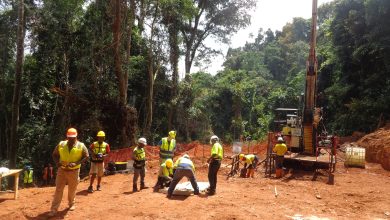
Hand-held X-ray Fluorescence (XRF) Spectrometers in Ore Grading
Competent Operators, Reliable Results
While the penetration of X-ray fluorescence (XRF) spectrometers has revolutionised ore sample analysis, it has not eliminated the need for best practice. Requisite operator competence has never been more critical to producing reliable results. This is what XRF specialist Maggi Loubser points out.
Advances in electronics and detectors, as well as software development, have made X-ray Fluorescence spectrometry seemingly effortless for the end user. As a result, XRF spectrometers, like other analytical instrumentation, have shrunk to such an extent that a geologist or operator can now easily have his own handheld XRF spectrometer with him in the field.As result, hand-held spectrometers have changed the game in mineral sample analysis.
Disruptive development
Hand-held XRF spectrometers have without any shadow of a doubt been one of the most disruptive developments in mining and exploration in the past decade. Suddenly the laboratory could be taken to the ore body without the need to wait for long laboratory turn-around times. An exploration team can get an in-situ indication of the ore grade, and the mine operators on where a seam runs.
Not a magic wand
However, while handheld XRF analysers offer incredible convenience, the catch is that the physics behind the technique has not shrunk. The physics of XRF spectroscopy has not changed nor the statistics of representative sampling.
For all its wonders, a handheld XRF spectrometer is not a magic wand. It can only analyse that which you put in front of that sample aperture, and the X-ray photons making it to the detector are even fewer due to geometry, the density of the sample, matrix effects etc.
This suggests that if the operator (the person behind the instrument) does not have insight into how data is generated and what the limitations are, gigabytes of meaningless data can easily be produced. The operator needs the requisite competence.
The biggest challenge that arises is where previously a carefully calculated volume of sample, representative of the ore body/seam was sent to the laboratory, where its size was decreased through a carefully designed comminution process to produce a representative analytical aliquot still representative of the original bulk, now, the operator just analyses unprepared random direct measurements and expects the data to correspond to the laboratory results.
Unsurprisingly, this is the reason why exploration geochemists have been and are still grappling with representative sampling since the 1950s when Pierre Gy (Gy P.M. 1976) published the first of his many works on the subject. (Esbensen 2014-2020)
Vital steps
Thus, there are vital steps that an operator has to follow to get reliable results from handheld XRF spectrometers. Worth mentioning are the following:
- Comparison between in-situ to laboratory analyses
For this reason, it is essential to experimentally compare the uncertainty from in-situ analyses to laboratory analyses, then, combine it with a cost/time benefit analysis, to decide whether the uncertainties are acceptable. Without practical evaluation of the results obtained in-situ, and an understanding of the uncertainties, the instrument is no more than a random number generator!
- Increasing analytical accuracy
Fortunately, many steps can be taken in the field to increase the accuracy of results a hundredfold in sample preparation. These include:
- Grinding and homogenising samples
Grinding samples fine and homogenising samples cause an exponential increase in analytical accuracy. In the laboratory, the sample is ground to a fineness small enough for the longest wavelength photons (light elements) in a sample, to escape the sample with equal probability than a shorter wavelength (heavier element).
Fortunately, today there is a lot of portable equipment used for the task. These vary from small manual crushers and mills operating with a small percussion drill and battery-operated grinders, or an angle grinder with a capture vessel enabling one to cut through a rock and collect representative sample dust.
- Drying samples
Drying samples is another vital process. Samples are dried to eliminate the effect of moisture on absorbing long wavelength light elements. In the laboratory they are ignited to get rid of volatile components like CO2 in a measurable fashion. This enables accurate recalculations of elements the XRF cannot determine due to their low atomic number, and followed by fusion to destroy the mineralogy and minimise matrix effects. In the field, a UV lamp can suffice in drying samples enough to make light element analyses more accurate.
iii. Optimal instrument calibration
To ensure the instrument is optimally calibrated for your specific matrix is crucial. Typically, the factory calibrations are executed with a wide set of matrices to cover as many matrices and large analytical ranges as possible, but at the cost of accuracy for a specific matrix.
Thus, it is crucial to evaluate the factory calibration on your material and use a slope and intercept adjustment with certified reference materials in your matrix, also called derivative calibrations. If your spectrometer has the ability, do a matrix-specific calibration on your material, or provide the factory with a set of reference materials in your matrix and ask them to do so at the time of purchase.
In addition, just as in a geochemistry laboratory, daily check samples are crucial to gauge the stability of an instrument. Typically, the sample window is often polypropylene, and it could be broken without anybody noticing, except that measurements will suddenly be much higher as the extra absorbing layer between the sample and detector is gone.
An instrument usually comes with a factory check sample, and this is important, because this data can always be compared to the factory commissioning data, but it is important to have a stable control sample including your elements of interest. This is even more important when a project uses multiple handheld instruments. In this case, you need a set of monitor sample data if you want to combine data from different spectrometers.
As a rule, handheld XRF spectrometers are incredibly robust and stable. Different from high-power systems, they do not decrease in sensitivity over time. Thus, when a tube or detector breaks, it breaks. The biggest agent of deterioration is operators who drop instruments or puncture detectors by pushing the instrument
directly against protruding rocks.
- Application of matrix correction software
Ultimately, all these steps ensure that the sophisticated matrix correction software is applied effectively to give the most accurate results.
- Determining a representative sample
A representative sample that is as accurate as possible must be determined. First of all, it is important to calculate how many in-situ analyses are necessary over a given area/volume to give representative results. Follow the same process as you would have done to determine your original carefully designed sampling plan for collecting material to send to the laboratory. Again, this involves taking the largest particle sizes, the density of the country rock, and the concentration of elements of interest into consideration. Compare these samples with laboratory analyses to calculate your uncertainty.
Selecting the right instrument
Plainly, it is critical to make informed decisions when it comes to selecting instruments used for an application. Usually, the lower-power instruments are used for metal sorting or heavy element analyses where the fluorescence yield of the elements of interest is high. For accurate light element analyses (Mg –S), a silicon drift detector is an absolute prerequisite and some instruments now come out with graphene or equivalent detector windows that absorb less of
the radiation coming from the sample leading to much higher sensitivity for light elements. For instance, Cl is a nightmare on a Rh tube instrument operated in an air atmosphere due to Argon peak overlap.
Higher-end instruments are calibrated with different power and filter settings for different parts of the periodic table and so all elements from Mg to U can be covered in three phases. Always ensure you have access to the manufacturer’s calibration tables to ensure your analytical range falls within the calibrated range, else a type of standard adjustment will be necessary to extrapolate the calibration maximum. Unfortunately, if you have a very unique matrix, a slope and intercept adjustment may not be enough to compensate for the difference in your material and the general factory calibration.
In a nutshell, there are several factors to be considered when determining the type
of XRF instrument to be used for a sample, specifically:
- Always consider your application and the fact that the needs may change over time.
- Get the most robust instrument you can afford with the most relevant factory calibrations you can afford.
- Ensure you can get good support and service from the supplier – often people buy less expensive instruments on the internet only to find out the manual is unreadable, and no local support is available.
- However, it is important to make the most of the convenience handheld XRF spectrometers offer. The most important issue is to commission your instrument properly before commencing any project. Do repeatability and reproducibility studies, test your sampling frequency, and test the accuracy against reliable laboratory analyses. Set up quality control protocols for each instrument and collect and store the data diligently should adjustments to data be necessary at a later stage. Remember, the spectrometer has no psychic abilities, it can only analyse that which the operator places in front of the analyser window!
Dramatic transformation of exploration geochemistry
From the foregoing, the main takeaway is that there is no question that handheld XRF spectrometers are probably the most exciting development in X-ray Fluorescence spectroscopy in the last decade. Since the silicon drift detectors were developed making light element analyses possible, this tool has transformed the capabilities of exploration geochemistry dramatically. However, the role of competent operators in producing reliable results has never been more critical.
Gy, P.M. 1976. The sampling of particulate materials – A general theory. International Journal of Mineral Processing, 3(4):289-312
Esbensen, K.H., et al. 2014-2020 Sampling Columns. Spectroscopy Europe Asia. https://www.spectroscopyeurope.com/sampling
Maggi Loubser is a Bruker-appointed Application specialist in South Africa and has 35 years of XRF experience and about 15 years of handheld experience. She consults intensively in the mining industry, especially handheld spectrometers. Currently she is based at the University of Pretoria.






